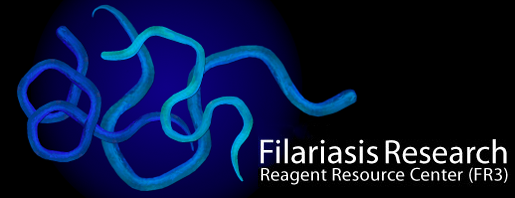Technical Tips
How much DNA/RNA is there in a worm?
Using FR3 protocols, we estimate the following:
Total RNA: 500 L3s yields 2.5-5 ug RNA => 5-10 ng RNA/L3
500 L4s yields 15-20 ug RNA => 30-40 ng RNA/L4
1 million mf yield 22 ug RNA => 2 ng RNA/100 mf
160 immature females yield 65 ug RNA => 400 ng RNA/female
8 adult males yield 14 ug RNA => 1.8 ug RNA/male
DNA: 500 L3s yield ~3 ug DNA => 6 ng DNA/L3
500 L4s yield ~6 ug DNA => 12 ng DNA/L4
5 adult females yield ~5 ug DNA => 1 ug DNA/adult female
How do I handle worms without damaging them?
This depends on your system, but camel hair brushes are the best for manipulating live or preserved worms outside of the host. Trying to get them from the peritoneal cavity? Flushing out the cavity using a plastic transfer pipet is a great way to get large numbers of undamaged worms. For those that are 'stuck', a small Jameson muscle hook works, or you can make your own by bending a tuberculin needle and placing it on the end of a cotton tip applicator (be careful not to slice worms with the bevel).
How do I preserve worms?
This depends on your purpose. For morphology work, live worms should be fixed in 50 degree C ethanol/glycerol fixative, or in cold 3% formalin. If using ethanol/glycerol, place the dish in an airy place to let the ethanol slowly evaporate, then the worms can be stored as they are in straight glycerine. The worms can later be cleared in lactophenol for examination. Whatever the method, store the worms loose in a vial.
For immunohistochemistry place live worms in 70% ethanol or 4% buffered formalin (paraformaldehyde may also work). For in situ hybridization, formalin or paraformaldehyde may be used. Samples may be maintained at room temperature or at 4 degrees C.
For RNA or DNA isolation, worms can be flash frozen (with or without buffer) in liquid nitrogen, then stored at -80 degrees C until use. Storing filarial worms in RNALater is NOT recommended, however to simplify downstream RNA isolation they can be frozen in Trizol and stored at -80. Storage in 100% alcohol may be feasible in the short term, but is not advisable for long term storage because DNA damage can occur. Where possible, DNA isolation should be performed as soon as possible on ethanol-preserved samples to avoid problems with PCR amplification. In cases where samples have been stored long term in ethanol, it may be possible to rescue them for PCR using a commercially available kit.
How do I preserve mosquitoes? Submitted by Sandra Laney, Smith College
To preserve filarial infected mosquitoes for DNA extraction, dry the mosquitoes using any available method. For example, place them in open tubes in direct sunlight for ~1-2 hours, place them in open tubes in a heat block at 90C for 15 - 30 minutes, or place them in an oven at 90C for 15-30 min. To keep dried mosquitoes for long term in humid climates, place them in a container and add drierite (example, put closed mosquito tubes in a box, put the box in a ziplock bag and add drierite to the bag and seal it). They can be stored at room temperature or at 4C or -20C.
To preserve filarial infected mosquitoes for RNA extraction use RNA later (Ambion, Inc.). The mosquitoes should be submerged in RNAlater as quickly as possible after knockdown. They will tend to float, so centrifuge, shake or manually push them down into the solution so that they all come in contact with the solution. When you are going to extract RNA from the mosquitoes it is critical to remove the RNAlater (the high salt concentration inhibits the efficient extraction of RNA). You can do this by removing the mosquitoes with forceps, blotting them on kimwipes and putting them in a new tube for RNA extraction, or pipette off all of the RNAlater, rinse with H2O and remove it before adding Trizol for RNA extraction.
Maximizing mf recovery while keeping you gerbil costs down. Submitted by Shelly Michalski, UW Oshkosh
Peritoneal lavage on anesthetized gerbils can be a frustrating practice. Many of us attempt it because we want to isolate mf from a patent IP infected gerbil that we don't want to sacrifice, but often mf recoveries are low because it is very difficult to recover injected media. This practice also puts the gerbil at risk for internal organ puncture. We have published a safer modified technique that uses gravity-assisted collection of peritoneal fluid through a catheter. This technique has greatly increased our mf yields, and greatly decreased the number of gerbils we have to sacrifice for mf collection. Interested? Please check out our article: Griffiths KG, Alworth LC, Harvey SB, Michalski ML. 2010. Using an intravenous catheter to carry out abdominal lavage in the gerbil. Lab Anim (NY). 2010 May;39(5):143-8. PMID: 20410898


